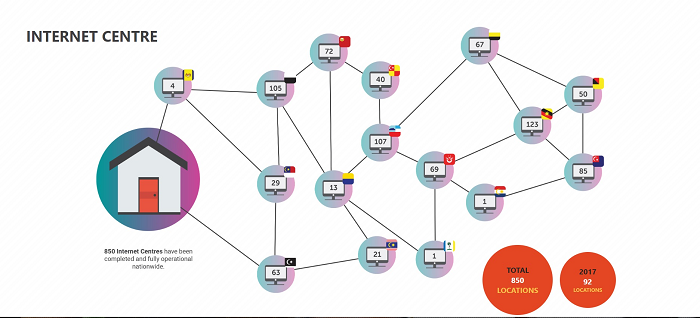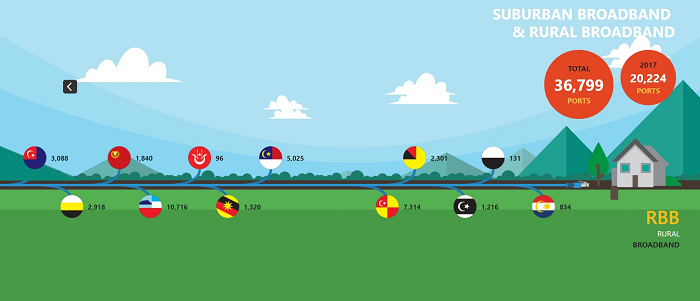Telco Deep Dive 2019: USP Report 2017 provides positive numbers, comparably increased efforts
By Tan Jee Yee September 5, 2019
- US$309mil collected from service providers with US$295mil used
- As a whole, MCMC feels USP 2017 targets are met, efforts increased

By Tan Jee Yee
Bigger. Wider. Better. If anything, the 2017 Universal Service Provision (USP) Annual Report by the Malaysian Communications and Multimedia Commission (MCMC) shows that steps towards improving the nation’s connectivity is ongoing, and that efforts have clearly increased.
To recap, the Universal Service Provision programme aims to provide collective and individual access to basic telephony and internet services throughout Malaysia. As MCMC puts it, service providers have a tendency to focus on commercially lucrative areas, which creates connectivity gaps between urban and rural areas – the Digital Divide, as it’s known.
This programme serves as a tool for bridging the divide by acting as a mechanism for channelling private sector investment into unprofitable rural areas.
It utilises the USP Fund, which has been established under the provision of Section 204 of the Communications and Multimedia Act (CMA) 1998. The fund is contributed by local communications companies.
The USP programme encompasses various aspects from the provision of communication infrastructures to the provision of broadband access. This includes smart device package offerings to consumers, especially in rural areas.
There are visible results, it seems. According to the 2017 report, effective implementation of the USP programme has contributed to the increase of the national broadband penetration rate. In Q3 2017, broadband penetration rate per 100 households has risen to 84.5% compared to 81.5% in 2016.

Hitting targets
At the very least, it seems that the USP programme has achieved targets that are part of other government transformation initiatives. This is especially true of the National Transfromation Programme through National Key Economic Areas (NKEA) under the Communications Content and Infrastructure’s sector (CCI).
Under the 2017 USP report, the programme essentially hit all of its targets. To start with, the programme manages to land its goal of new communications towers in 300 locations in 2017 (it reached 302 locations).
In addition, the target of having 317,000 ports for suburban broadband was also reached. Some targets are exceeded even, albeit slightly – the target to achieve 500 base transceiver stations in 2017 was achieved with 510 base stations instead. The aim to have 50 internet centres by 2017 is met with 52 centres.
But perhaps the most positive take away from the report is the increased amounts of new installations and inclusions compared to previous years. For instance, the programme saw 20,224 new rural broadband ports installed in 2017 compared to 9,875 in 2016. In total, there are now 36,799 rural broadband ports as of 2017.
Other significant leaps in number include the 748,667 units of smart devices provided with internet packages compared to the 435,604 units in 2016 (totalling 2,428,160 units across the nation). 2017 also saw 1,928 existing towers being upgraded compared to 1,298 in 2016. As a whole, 3,978 existing tower locations in Malaysia has been upgraded.

Community outreach
Providing internet access to rural and underserved areas isn’t just limited to expanding coverage. USP initiatives also include the provision of internet centres and community Wi-Fi access, which – according to the 2017 – seems to be progressing steadily.
As of 31 December 2017, there is a total of 850 internet centres that have been completed and fully operational nationwide. 92 of them are implemented in 2017.
These centres provide internet access facilities with minimal charges as well as ICT and entrepreneurship training for free. Visitors can also gain accesses to additional services that include printing, photocopying, scanning and lamination. Such internet centres are typically focused on underserved areas (rural areas, for instance) and underserved groups (communities in low-cost housing areas).
It’s fairly heartening to see, at least, that the states with the most internet centres are in East Malaysia. Sarawak leads the way with 123 centres, while Sabah has 107. At the same time, one certainly hopes that this isn’t enough to placate the massive need to expand broadband coverage across those states.
It’s also good to see an increase in Community Wi-Fi (WK) areas. These are hotspots that provide internet access in selected locations within 3km from the internet centres. Access is free, even for online businesses.
The country now has 2,502 of such hotpots as of December 2017, with 311 new WK implementations in 2017. As with internet centres, East Malaysia leads the way with number of WKs per state – 412 in Sarawak, and 377 in Sabah.
Another interesting stat from the 2017 USP report is the fact that there are currently 1,252 units of public payphones that are still operating and maintained throughout the country. 896 of them are situated in Sarawak alone, with 76 in Pahang and 68 in Sabah. There are only 12 in Selangor, and 3 in Negeri Sembilan.
Payphones are considered part of the telephony initiative, which began in 2002 with the aim of providing access to basic telephony facilities. Implementation is focused on areas where basic telephony penetration rate is 20% below the national penetration rate.
As the report notes, demand and usage of public payphones has declined due to development in mobile phone technology, though MCMC will continue to maintain it as long as the demand exists. The number of payphones did not increase since 2016, though.

Expanding broadband
What of the country’s efforts to expand national broadband coverage? Well, there are more new communication towers, at least. A total of 1,664 new communication towers have been successfully built and activated throughout the country thus far.
It’s worth noting that these “new” communications towers began construction in 2009, and were implemented through two major projects, both which would total up to 2,000 new communication towers.
The rate of new towers has declined since 2016, however. In the previous USP report, 396 new towers were activated. Only 262 were completed in 2017.
Sarawak once again leads in numbers. The state has 410 new communication towers, while Sabah has 344. Pahang, on the other hand, has 293.
Building new towers aren’t just the only solution to reaching the underserved, of course. MCMC has also upgraded existing communication towers to accommodate the increasing demand for mobile broadband. As of the end of 2017, 3,978 existing communication tower’s base transceiver stations have been upgraded nationwide.
As stated earlier, 1,928 of these stations were upgraded in 2017. 940 of them are from Sabah alone, while 859 stations from Sarawak and 561 stations from Pahang saw upgrades as well.
The Suburban Broadband (SUBB) and Rural Broadband (RBB) initiatives are seeing some progress as well. Both were introduced to expand high-speed broadband coverage in suburban and rural areas with speeds of up to 20Mbps. SUBB is implemented through public-private partnership between MCMC and service providers while the RBB is fully funded under the USP programme.
As of December 2017, a total of 366,294 ports have been implemented nationwide under the SUBB initiative (160,216 ports implemented in 2017), while the RBB initiative saw 36,799 ports in total, with 20,224 being implemented in 2017.
The USP Fund, and going forward
The 2017 USP report also revealed that a total of US$309 million (RM1.31 billion) was “recognised as income” for the USP fund for 2017. Contribution to the USP Fund is calculated based on the submitted return of the net revenue from designated services by all licensees, on top of interest income.
The major contributors to the USP Fund in 2017 include Maxis Broadband, Maxis Mobile, Celcom Network, Digi Telecommunications, edotco Malaysia, Telekom Malaysia, TT dotcom (TIME), YTL Comm and Sacofa.
MCMC noted in the report that US$295 million (RM1.24 billion) was used by service providers in 2017 for the implementation of USP projects.
Going forward, it will be interesting to see what the next USP report will show. The Pakatan Harapan government came into power on May 2018, and with it came sweeping reforms in the communications and multimedia aspect.
This includes the just announced National Fiberisation and Connectivity Plan (NFCP), which targets to have at least 98% of key populated areas covered with at least 30Mbps broadband by 2023. 5G wireless technology is now a national priority as much as it is a buzzword, while broadband prices have been reduced.
The Ministry of Communications and Multimedia last year also said that it will conduct an audit on two MCMC fund groups – the USP Fund being one of them.
One can certainly hope that the numbers above see significant rise. For years we’ve considered the Digital Divide as an impediment to the country’s high-income nation goals. It’s time we bridge it with all we have.
Related stories:
Telco Deep Dive: consolidation needed to improve industry economics and speed of implementation
One in six Malaysians are still overpaying for broadband: iMoney survey
MCMC to cooperate with MACC on fund management issues
Malaysian telcos, MCMC pledge to improve consumer experience


